Application of Nursing Practice in the Primary Health Care Setting
VerifiedAdded on 2023/06/03
|8
|2309
|219
AI Summary
This article discusses nursing practice in primary health care, including prevention strategies for asbestosis and melanoma, signs and symptoms of coronary heart disease, community resources for coronary heart disease, and dementia care.
Contribute Materials
Your contribution can guide someone’s learning journey. Share your
documents today.
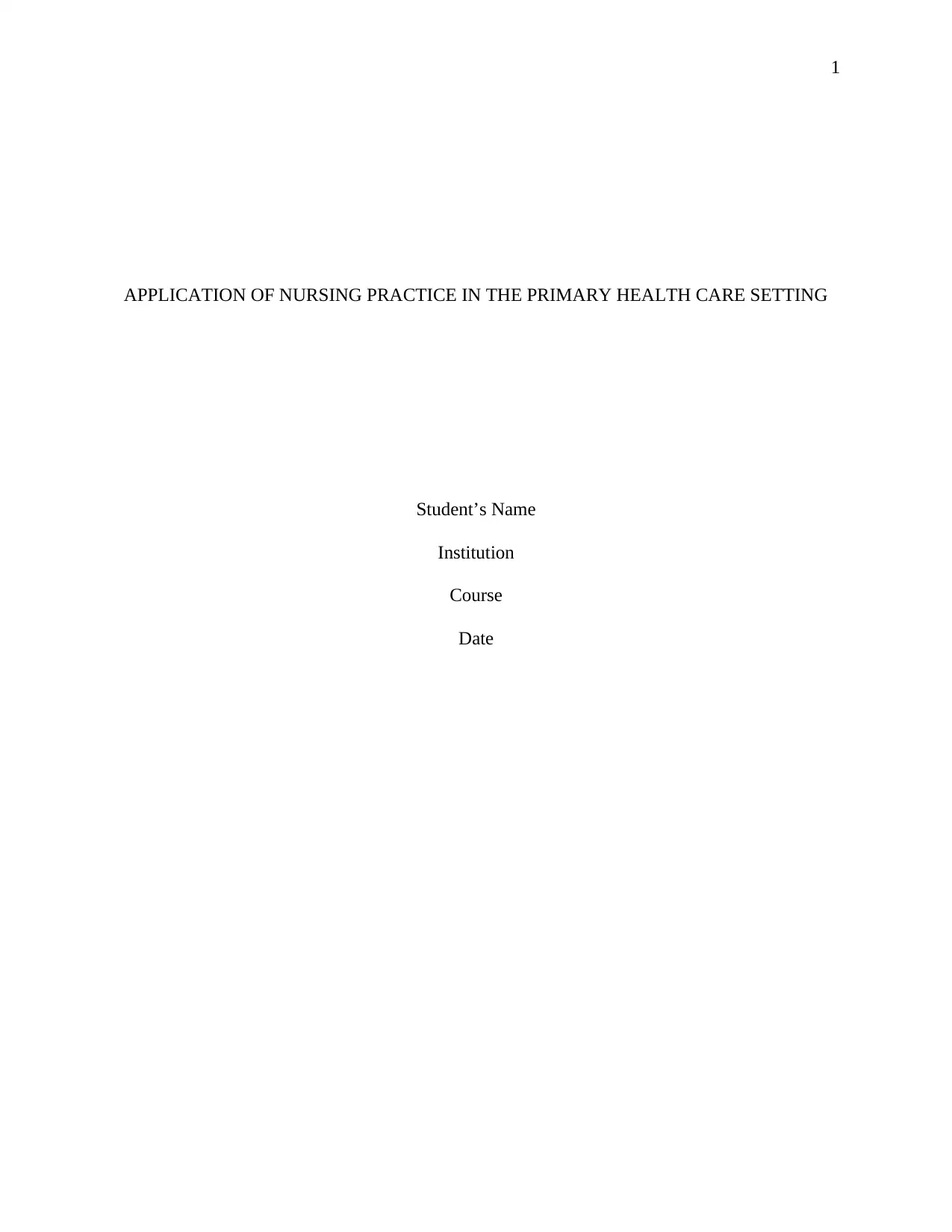
1
APPLICATION OF NURSING PRACTICE IN THE PRIMARY HEALTH CARE SETTING
Student’s Name
Institution
Course
Date
APPLICATION OF NURSING PRACTICE IN THE PRIMARY HEALTH CARE SETTING
Student’s Name
Institution
Course
Date
Secure Best Marks with AI Grader
Need help grading? Try our AI Grader for instant feedback on your assignments.

2
Application of Nursing Practice in the Primary Health Care Setting
Assessment Task 1
Question 1
Primary health care refer to care provided in the community for individuals making first
approach or appearance to a care provider for treatment or advice. Primary health care entails
caring for persons instead of simply treating particular conditions or diseases (Brownson et al.
2017, p. 17). On the other hand, the philosophy of health care involves the study of people,
processes, and ethics that constitute the maintenance of health for humans. The philosophy of
health care is principally concerned with administration of health care, fundamental rights of all
individuals, cost of treatments, drugs, and hospital, and clinical trials.
Question 2
Health refers to the state of an individual being free from injury and morbidity or illness
or a state of complete social, mental, and physical wellbeing. Health illness continuum refers to a
graphical representation of well-being concept (Schomerus et al. 2016, p. 23). It suggests that
well-being encompasses emotional and mental health and absence or presence of illness.
Additionally, it posits that people can move farther to the right, toward greater well-being and
health, passing via the phases of growth, education, and awareness. According the health illness
continuum, a negative outlook hinders wellbeing and health while a positive outlook enhances
wellbeing and health.
Question 3
Primary health prevention strategies for asbestosis include eliminating the exposure via
substitution with other materials (Shin et al. 2018, p. 918). This would eradicate the risks of
developing pleural-related changes and asbestosis. Additionally, asbestosis can be prevented
Application of Nursing Practice in the Primary Health Care Setting
Assessment Task 1
Question 1
Primary health care refer to care provided in the community for individuals making first
approach or appearance to a care provider for treatment or advice. Primary health care entails
caring for persons instead of simply treating particular conditions or diseases (Brownson et al.
2017, p. 17). On the other hand, the philosophy of health care involves the study of people,
processes, and ethics that constitute the maintenance of health for humans. The philosophy of
health care is principally concerned with administration of health care, fundamental rights of all
individuals, cost of treatments, drugs, and hospital, and clinical trials.
Question 2
Health refers to the state of an individual being free from injury and morbidity or illness
or a state of complete social, mental, and physical wellbeing. Health illness continuum refers to a
graphical representation of well-being concept (Schomerus et al. 2016, p. 23). It suggests that
well-being encompasses emotional and mental health and absence or presence of illness.
Additionally, it posits that people can move farther to the right, toward greater well-being and
health, passing via the phases of growth, education, and awareness. According the health illness
continuum, a negative outlook hinders wellbeing and health while a positive outlook enhances
wellbeing and health.
Question 3
Primary health prevention strategies for asbestosis include eliminating the exposure via
substitution with other materials (Shin et al. 2018, p. 918). This would eradicate the risks of
developing pleural-related changes and asbestosis. Additionally, asbestosis can be prevented
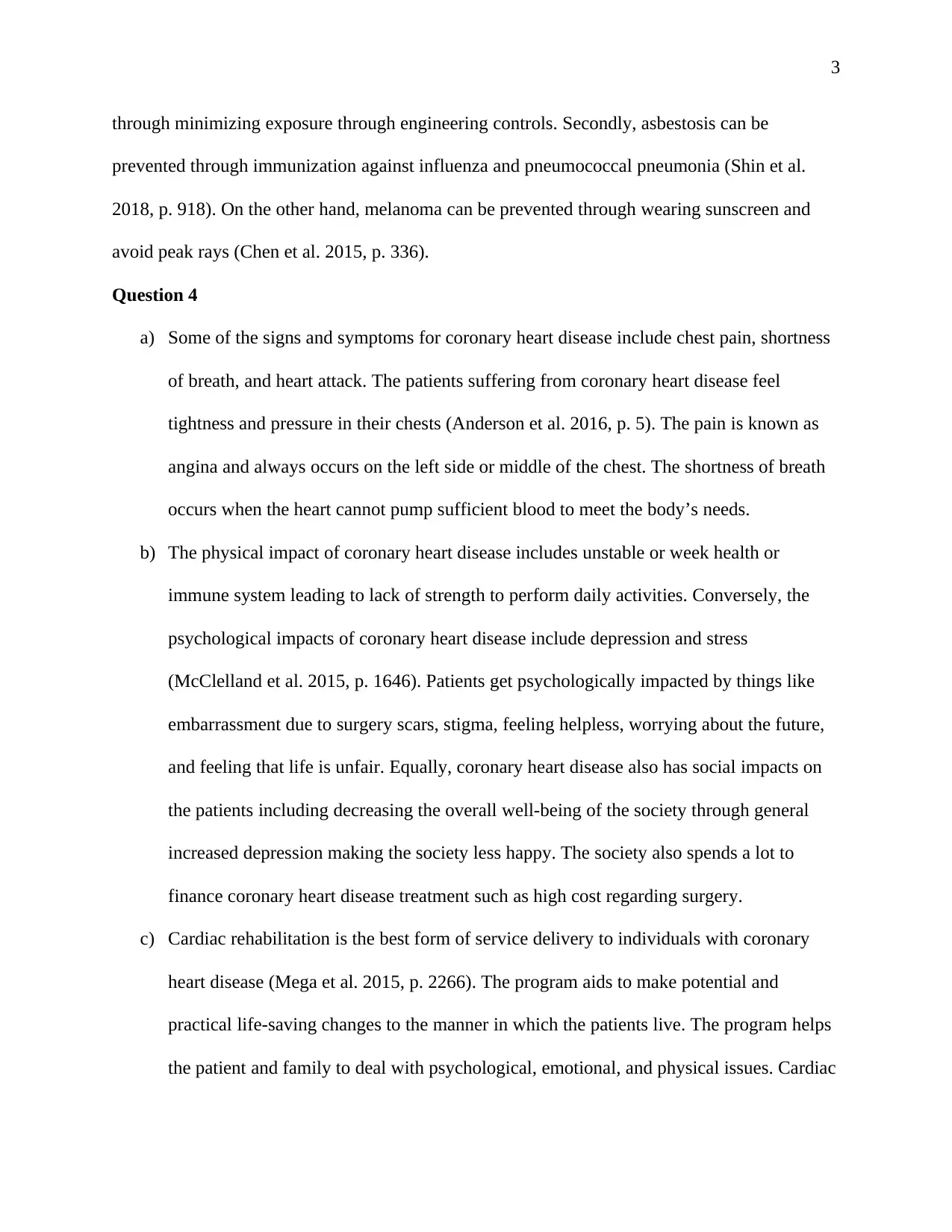
3
through minimizing exposure through engineering controls. Secondly, asbestosis can be
prevented through immunization against influenza and pneumococcal pneumonia (Shin et al.
2018, p. 918). On the other hand, melanoma can be prevented through wearing sunscreen and
avoid peak rays (Chen et al. 2015, p. 336).
Question 4
a) Some of the signs and symptoms for coronary heart disease include chest pain, shortness
of breath, and heart attack. The patients suffering from coronary heart disease feel
tightness and pressure in their chests (Anderson et al. 2016, p. 5). The pain is known as
angina and always occurs on the left side or middle of the chest. The shortness of breath
occurs when the heart cannot pump sufficient blood to meet the body’s needs.
b) The physical impact of coronary heart disease includes unstable or week health or
immune system leading to lack of strength to perform daily activities. Conversely, the
psychological impacts of coronary heart disease include depression and stress
(McClelland et al. 2015, p. 1646). Patients get psychologically impacted by things like
embarrassment due to surgery scars, stigma, feeling helpless, worrying about the future,
and feeling that life is unfair. Equally, coronary heart disease also has social impacts on
the patients including decreasing the overall well-being of the society through general
increased depression making the society less happy. The society also spends a lot to
finance coronary heart disease treatment such as high cost regarding surgery.
c) Cardiac rehabilitation is the best form of service delivery to individuals with coronary
heart disease (Mega et al. 2015, p. 2266). The program aids to make potential and
practical life-saving changes to the manner in which the patients live. The program helps
the patient and family to deal with psychological, emotional, and physical issues. Cardiac
through minimizing exposure through engineering controls. Secondly, asbestosis can be
prevented through immunization against influenza and pneumococcal pneumonia (Shin et al.
2018, p. 918). On the other hand, melanoma can be prevented through wearing sunscreen and
avoid peak rays (Chen et al. 2015, p. 336).
Question 4
a) Some of the signs and symptoms for coronary heart disease include chest pain, shortness
of breath, and heart attack. The patients suffering from coronary heart disease feel
tightness and pressure in their chests (Anderson et al. 2016, p. 5). The pain is known as
angina and always occurs on the left side or middle of the chest. The shortness of breath
occurs when the heart cannot pump sufficient blood to meet the body’s needs.
b) The physical impact of coronary heart disease includes unstable or week health or
immune system leading to lack of strength to perform daily activities. Conversely, the
psychological impacts of coronary heart disease include depression and stress
(McClelland et al. 2015, p. 1646). Patients get psychologically impacted by things like
embarrassment due to surgery scars, stigma, feeling helpless, worrying about the future,
and feeling that life is unfair. Equally, coronary heart disease also has social impacts on
the patients including decreasing the overall well-being of the society through general
increased depression making the society less happy. The society also spends a lot to
finance coronary heart disease treatment such as high cost regarding surgery.
c) Cardiac rehabilitation is the best form of service delivery to individuals with coronary
heart disease (Mega et al. 2015, p. 2266). The program aids to make potential and
practical life-saving changes to the manner in which the patients live. The program helps
the patient and family to deal with psychological, emotional, and physical issues. Cardiac

4
rehabilitation also complements the cardiologist or doctor’s advice (Jousilahti et al. 2016,
p. 367). In contrary, the preventive forms of service delivery to people with coronary
heart disease include control of cholesterol and blood pressure, smoking cessation,
physical activity, and nutritious eating. Lastly, the curative forms of service delivery to
coronary heart disease patients include taking the drugs such as aspirins, beta-blockers,
clopidogrel, and ACE inhibitors as prescribed by the doctor.
d) Some of the community resources for individuals with coronary heart disease include
development of supportive environment for healthy eating and physical activity. The
community provides large field where the patients can do exercise, for example, ride
bicycles. The community also offers healthy eating through availing fruits and vegetables
for the patients. Fruits and vegetables are rich in important minerals such as calcium
which help in formation of bones hence immune strengthening. Contrariwise, the in-
hospital resources for patient with coronary heart disease include professionals such as
doctors who offer interventional treatment. The hospitals also have drugs such as aspirins
which help in coronary heart disease cure.
Question 5
The primary literatures associated with the primary health care management of coronary
heart disease include the Nursing in Primary Health Care (NiPHC) and “My Heart, My Life-
which refers to a guide for individuals living with coronary heart disease. The literatures
offer an interactive self-management resource for individuals with coronary heart disease or
have high risks of coronary heart disease. They reflect on the content of eradicating the risks
in heart disease and offer psychosocial, medical, and lifestyle strategies to decrease the risks
of further heart problem. On a similar note, some of the professional bodies associated with
rehabilitation also complements the cardiologist or doctor’s advice (Jousilahti et al. 2016,
p. 367). In contrary, the preventive forms of service delivery to people with coronary
heart disease include control of cholesterol and blood pressure, smoking cessation,
physical activity, and nutritious eating. Lastly, the curative forms of service delivery to
coronary heart disease patients include taking the drugs such as aspirins, beta-blockers,
clopidogrel, and ACE inhibitors as prescribed by the doctor.
d) Some of the community resources for individuals with coronary heart disease include
development of supportive environment for healthy eating and physical activity. The
community provides large field where the patients can do exercise, for example, ride
bicycles. The community also offers healthy eating through availing fruits and vegetables
for the patients. Fruits and vegetables are rich in important minerals such as calcium
which help in formation of bones hence immune strengthening. Contrariwise, the in-
hospital resources for patient with coronary heart disease include professionals such as
doctors who offer interventional treatment. The hospitals also have drugs such as aspirins
which help in coronary heart disease cure.
Question 5
The primary literatures associated with the primary health care management of coronary
heart disease include the Nursing in Primary Health Care (NiPHC) and “My Heart, My Life-
which refers to a guide for individuals living with coronary heart disease. The literatures
offer an interactive self-management resource for individuals with coronary heart disease or
have high risks of coronary heart disease. They reflect on the content of eradicating the risks
in heart disease and offer psychosocial, medical, and lifestyle strategies to decrease the risks
of further heart problem. On a similar note, some of the professional bodies associated with
Paraphrase This Document
Need a fresh take? Get an instant paraphrase of this document with our AI Paraphraser
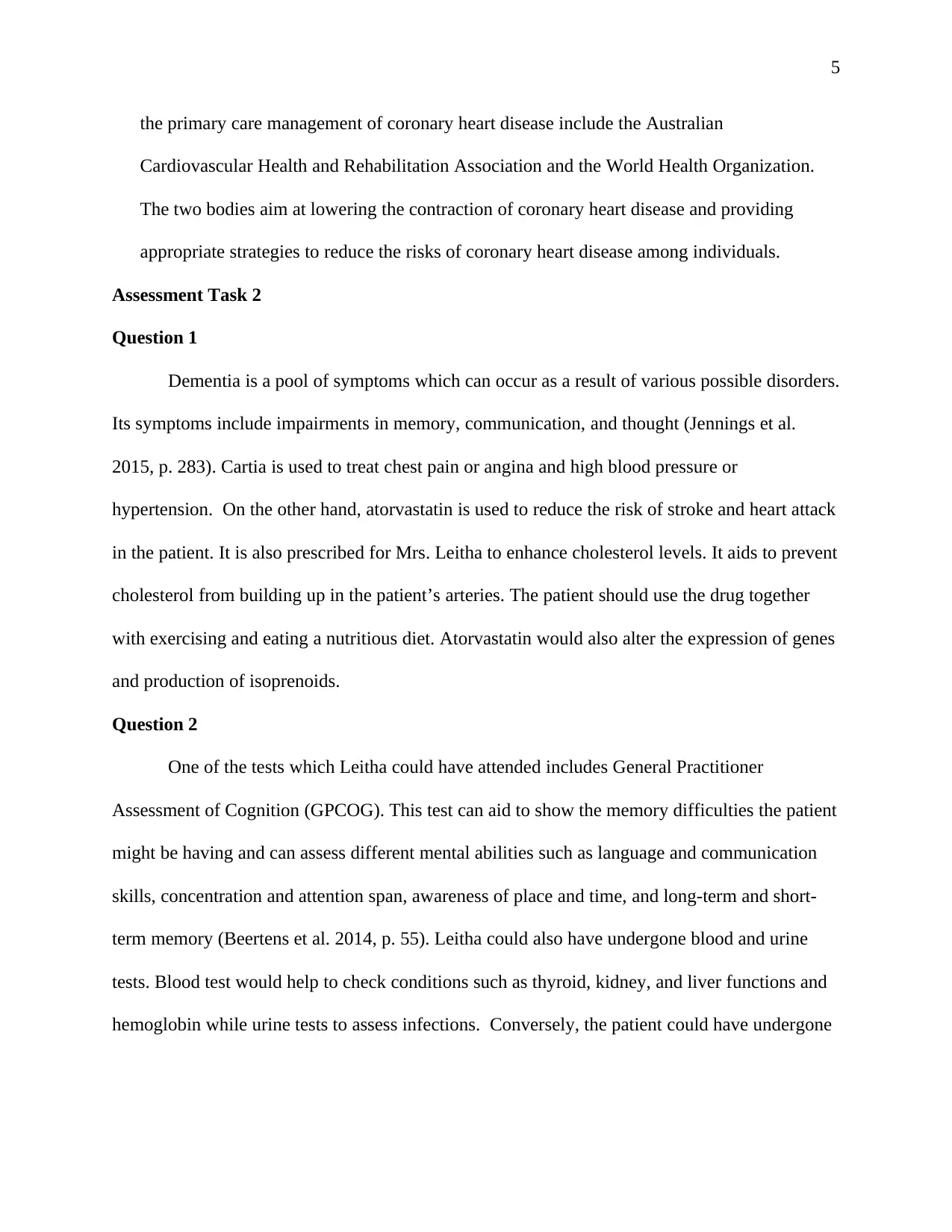
5
the primary care management of coronary heart disease include the Australian
Cardiovascular Health and Rehabilitation Association and the World Health Organization.
The two bodies aim at lowering the contraction of coronary heart disease and providing
appropriate strategies to reduce the risks of coronary heart disease among individuals.
Assessment Task 2
Question 1
Dementia is a pool of symptoms which can occur as a result of various possible disorders.
Its symptoms include impairments in memory, communication, and thought (Jennings et al.
2015, p. 283). Cartia is used to treat chest pain or angina and high blood pressure or
hypertension. On the other hand, atorvastatin is used to reduce the risk of stroke and heart attack
in the patient. It is also prescribed for Mrs. Leitha to enhance cholesterol levels. It aids to prevent
cholesterol from building up in the patient’s arteries. The patient should use the drug together
with exercising and eating a nutritious diet. Atorvastatin would also alter the expression of genes
and production of isoprenoids.
Question 2
One of the tests which Leitha could have attended includes General Practitioner
Assessment of Cognition (GPCOG). This test can aid to show the memory difficulties the patient
might be having and can assess different mental abilities such as language and communication
skills, concentration and attention span, awareness of place and time, and long-term and short-
term memory (Beertens et al. 2014, p. 55). Leitha could also have undergone blood and urine
tests. Blood test would help to check conditions such as thyroid, kidney, and liver functions and
hemoglobin while urine tests to assess infections. Conversely, the patient could have undergone
the primary care management of coronary heart disease include the Australian
Cardiovascular Health and Rehabilitation Association and the World Health Organization.
The two bodies aim at lowering the contraction of coronary heart disease and providing
appropriate strategies to reduce the risks of coronary heart disease among individuals.
Assessment Task 2
Question 1
Dementia is a pool of symptoms which can occur as a result of various possible disorders.
Its symptoms include impairments in memory, communication, and thought (Jennings et al.
2015, p. 283). Cartia is used to treat chest pain or angina and high blood pressure or
hypertension. On the other hand, atorvastatin is used to reduce the risk of stroke and heart attack
in the patient. It is also prescribed for Mrs. Leitha to enhance cholesterol levels. It aids to prevent
cholesterol from building up in the patient’s arteries. The patient should use the drug together
with exercising and eating a nutritious diet. Atorvastatin would also alter the expression of genes
and production of isoprenoids.
Question 2
One of the tests which Leitha could have attended includes General Practitioner
Assessment of Cognition (GPCOG). This test can aid to show the memory difficulties the patient
might be having and can assess different mental abilities such as language and communication
skills, concentration and attention span, awareness of place and time, and long-term and short-
term memory (Beertens et al. 2014, p. 55). Leitha could also have undergone blood and urine
tests. Blood test would help to check conditions such as thyroid, kidney, and liver functions and
hemoglobin while urine tests to assess infections. Conversely, the patient could have undergone
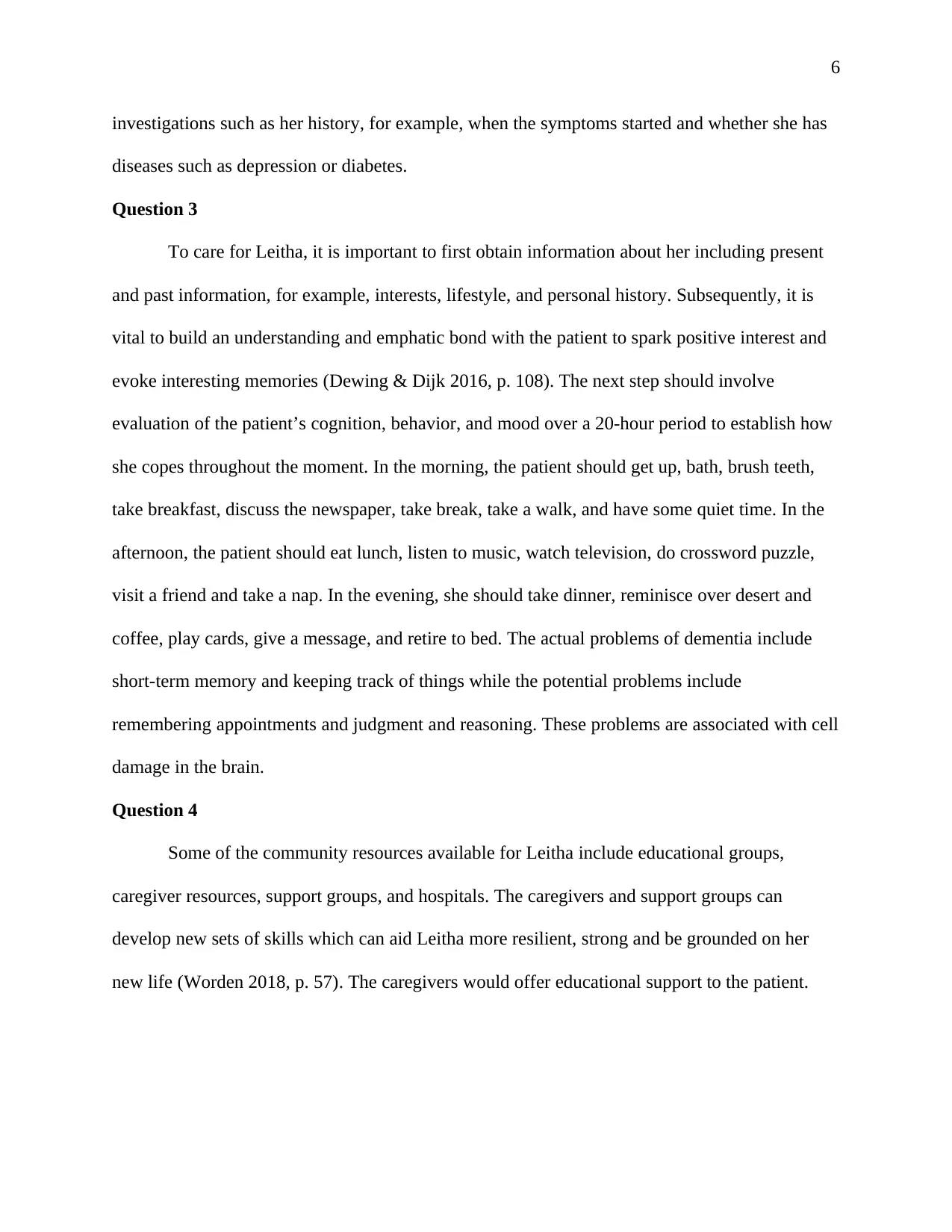
6
investigations such as her history, for example, when the symptoms started and whether she has
diseases such as depression or diabetes.
Question 3
To care for Leitha, it is important to first obtain information about her including present
and past information, for example, interests, lifestyle, and personal history. Subsequently, it is
vital to build an understanding and emphatic bond with the patient to spark positive interest and
evoke interesting memories (Dewing & Dijk 2016, p. 108). The next step should involve
evaluation of the patient’s cognition, behavior, and mood over a 20-hour period to establish how
she copes throughout the moment. In the morning, the patient should get up, bath, brush teeth,
take breakfast, discuss the newspaper, take break, take a walk, and have some quiet time. In the
afternoon, the patient should eat lunch, listen to music, watch television, do crossword puzzle,
visit a friend and take a nap. In the evening, she should take dinner, reminisce over desert and
coffee, play cards, give a message, and retire to bed. The actual problems of dementia include
short-term memory and keeping track of things while the potential problems include
remembering appointments and judgment and reasoning. These problems are associated with cell
damage in the brain.
Question 4
Some of the community resources available for Leitha include educational groups,
caregiver resources, support groups, and hospitals. The caregivers and support groups can
develop new sets of skills which can aid Leitha more resilient, strong and be grounded on her
new life (Worden 2018, p. 57). The caregivers would offer educational support to the patient.
investigations such as her history, for example, when the symptoms started and whether she has
diseases such as depression or diabetes.
Question 3
To care for Leitha, it is important to first obtain information about her including present
and past information, for example, interests, lifestyle, and personal history. Subsequently, it is
vital to build an understanding and emphatic bond with the patient to spark positive interest and
evoke interesting memories (Dewing & Dijk 2016, p. 108). The next step should involve
evaluation of the patient’s cognition, behavior, and mood over a 20-hour period to establish how
she copes throughout the moment. In the morning, the patient should get up, bath, brush teeth,
take breakfast, discuss the newspaper, take break, take a walk, and have some quiet time. In the
afternoon, the patient should eat lunch, listen to music, watch television, do crossword puzzle,
visit a friend and take a nap. In the evening, she should take dinner, reminisce over desert and
coffee, play cards, give a message, and retire to bed. The actual problems of dementia include
short-term memory and keeping track of things while the potential problems include
remembering appointments and judgment and reasoning. These problems are associated with cell
damage in the brain.
Question 4
Some of the community resources available for Leitha include educational groups,
caregiver resources, support groups, and hospitals. The caregivers and support groups can
develop new sets of skills which can aid Leitha more resilient, strong and be grounded on her
new life (Worden 2018, p. 57). The caregivers would offer educational support to the patient.
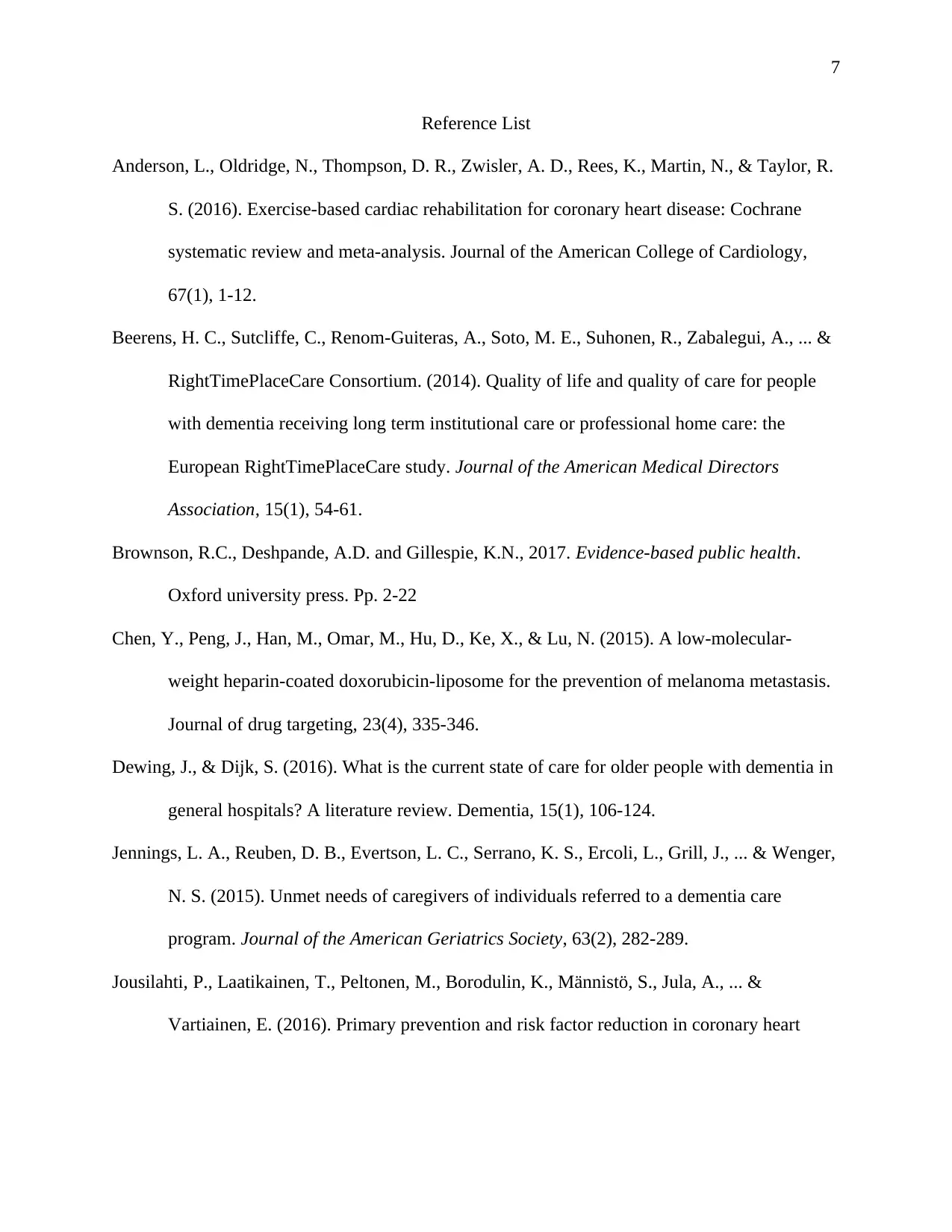
7
Reference List
Anderson, L., Oldridge, N., Thompson, D. R., Zwisler, A. D., Rees, K., Martin, N., & Taylor, R.
S. (2016). Exercise-based cardiac rehabilitation for coronary heart disease: Cochrane
systematic review and meta-analysis. Journal of the American College of Cardiology,
67(1), 1-12.
Beerens, H. C., Sutcliffe, C., Renom-Guiteras, A., Soto, M. E., Suhonen, R., Zabalegui, A., ... &
RightTimePlaceCare Consortium. (2014). Quality of life and quality of care for people
with dementia receiving long term institutional care or professional home care: the
European RightTimePlaceCare study. Journal of the American Medical Directors
Association, 15(1), 54-61.
Brownson, R.C., Deshpande, A.D. and Gillespie, K.N., 2017. Evidence-based public health.
Oxford university press. Pp. 2-22
Chen, Y., Peng, J., Han, M., Omar, M., Hu, D., Ke, X., & Lu, N. (2015). A low-molecular-
weight heparin-coated doxorubicin-liposome for the prevention of melanoma metastasis.
Journal of drug targeting, 23(4), 335-346.
Dewing, J., & Dijk, S. (2016). What is the current state of care for older people with dementia in
general hospitals? A literature review. Dementia, 15(1), 106-124.
Jennings, L. A., Reuben, D. B., Evertson, L. C., Serrano, K. S., Ercoli, L., Grill, J., ... & Wenger,
N. S. (2015). Unmet needs of caregivers of individuals referred to a dementia care
program. Journal of the American Geriatrics Society, 63(2), 282-289.
Jousilahti, P., Laatikainen, T., Peltonen, M., Borodulin, K., Männistö, S., Jula, A., ... &
Vartiainen, E. (2016). Primary prevention and risk factor reduction in coronary heart
Reference List
Anderson, L., Oldridge, N., Thompson, D. R., Zwisler, A. D., Rees, K., Martin, N., & Taylor, R.
S. (2016). Exercise-based cardiac rehabilitation for coronary heart disease: Cochrane
systematic review and meta-analysis. Journal of the American College of Cardiology,
67(1), 1-12.
Beerens, H. C., Sutcliffe, C., Renom-Guiteras, A., Soto, M. E., Suhonen, R., Zabalegui, A., ... &
RightTimePlaceCare Consortium. (2014). Quality of life and quality of care for people
with dementia receiving long term institutional care or professional home care: the
European RightTimePlaceCare study. Journal of the American Medical Directors
Association, 15(1), 54-61.
Brownson, R.C., Deshpande, A.D. and Gillespie, K.N., 2017. Evidence-based public health.
Oxford university press. Pp. 2-22
Chen, Y., Peng, J., Han, M., Omar, M., Hu, D., Ke, X., & Lu, N. (2015). A low-molecular-
weight heparin-coated doxorubicin-liposome for the prevention of melanoma metastasis.
Journal of drug targeting, 23(4), 335-346.
Dewing, J., & Dijk, S. (2016). What is the current state of care for older people with dementia in
general hospitals? A literature review. Dementia, 15(1), 106-124.
Jennings, L. A., Reuben, D. B., Evertson, L. C., Serrano, K. S., Ercoli, L., Grill, J., ... & Wenger,
N. S. (2015). Unmet needs of caregivers of individuals referred to a dementia care
program. Journal of the American Geriatrics Society, 63(2), 282-289.
Jousilahti, P., Laatikainen, T., Peltonen, M., Borodulin, K., Männistö, S., Jula, A., ... &
Vartiainen, E. (2016). Primary prevention and risk factor reduction in coronary heart
Secure Best Marks with AI Grader
Need help grading? Try our AI Grader for instant feedback on your assignments.

8
disease mortality among working aged men and women in eastern Finland over 40 years:
population based observational study. bmj, 352, i721.
McClelland, R. L., Jorgensen, N. W., Budoff, M., Blaha, M. J., Post, W. S., Kronmal, R. A., ... &
Folsom, A. R. (2015). 10-year coronary heart disease risk prediction using coronary
artery calcium and traditional risk factors: derivation in the MESA (Multi-Ethnic Study
of Atherosclerosis) with validation in the HNR (Heinz Nixdorf Recall) study and the
DHS (Dallas Heart Study). Journal of the American College of Cardiology, 66(15), 1643-
1653.
Mega, J. L., Stitziel, N. O., Smith, J. G., Chasman, D. I., Caulfield, M. J., Devlin, J. J., ... &
Poulter, N. R. (2015). Genetic risk, coronary heart disease events, and the clinical benefit
of statin therapy: an analysis of primary and secondary prevention trials. The Lancet,
385(9984), 2264-2271.
Schomerus, G., Angermeyer, M. C., Baumeister, S. E., Stolzenburg, S., Link, B. G., & Phelan, J.
C. (2016). An online intervention using information on the mental health-mental illness
continuum to reduce stigma. European Psychiatry, 32, 21-27.
Shin, H., Choi, Y., Jeon, B., Ha, J., Sun, Y., & Park, W. (2018). Improvement in the prevention
of asbestos fibre release from ceiling materials by increasing the penetration of a silicate
stabilizer through dilution. Indoor and Built Environment, 27(7), 917-924.
Worden, J. W. (2018). Grief counseling and grief therapy: A handbook for the mental health
practitioner. Springer Publishing Company. 35-89
disease mortality among working aged men and women in eastern Finland over 40 years:
population based observational study. bmj, 352, i721.
McClelland, R. L., Jorgensen, N. W., Budoff, M., Blaha, M. J., Post, W. S., Kronmal, R. A., ... &
Folsom, A. R. (2015). 10-year coronary heart disease risk prediction using coronary
artery calcium and traditional risk factors: derivation in the MESA (Multi-Ethnic Study
of Atherosclerosis) with validation in the HNR (Heinz Nixdorf Recall) study and the
DHS (Dallas Heart Study). Journal of the American College of Cardiology, 66(15), 1643-
1653.
Mega, J. L., Stitziel, N. O., Smith, J. G., Chasman, D. I., Caulfield, M. J., Devlin, J. J., ... &
Poulter, N. R. (2015). Genetic risk, coronary heart disease events, and the clinical benefit
of statin therapy: an analysis of primary and secondary prevention trials. The Lancet,
385(9984), 2264-2271.
Schomerus, G., Angermeyer, M. C., Baumeister, S. E., Stolzenburg, S., Link, B. G., & Phelan, J.
C. (2016). An online intervention using information on the mental health-mental illness
continuum to reduce stigma. European Psychiatry, 32, 21-27.
Shin, H., Choi, Y., Jeon, B., Ha, J., Sun, Y., & Park, W. (2018). Improvement in the prevention
of asbestos fibre release from ceiling materials by increasing the penetration of a silicate
stabilizer through dilution. Indoor and Built Environment, 27(7), 917-924.
Worden, J. W. (2018). Grief counseling and grief therapy: A handbook for the mental health
practitioner. Springer Publishing Company. 35-89
1 out of 8
![[object Object]](/_next/static/media/star-bottom.7253800d.svg)





